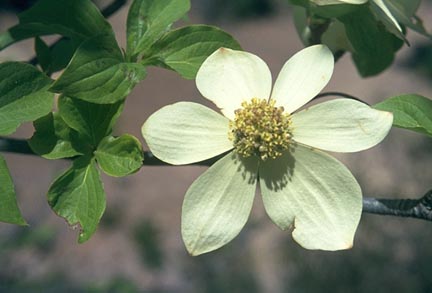
Species (common name, Latin
name)
Pacific dogwood (Cornus nuttallii)
Range
Pacific coast inland approximately 200 miles, from
Climate, elevation
Maritime to submaritime cool mesothermal climates. Minimum temperature is 7 degrees
Celsius. Grows from near sea to 6,000
feet with elevation limits of 3,500 feet in
Local occurrence (where, how
common)
Habitat preferences
Deep, moist, well-drained, acidic soils that are relatively
stone-free, high in nitrogen, with a rich humus
cover. (USDA)
Plant strategy type/successional stage (stress-tolerator,
competitor, weedy/colonizer, seral, late successional)
This tree is considered by some to be a climax species on
mesic sites, while others view it as a seral species in mesothermal
forests. It is shade tolerant until a
full canopy is developed. (USDA)
Associated species
Douglas-fir (Pseudotsuga
menziesii), ponderosa pine (Pinus
ponderosa), Western white pine (Pinus monticola), grand fir (Abies
grandis),
May be
collected as: (seed, layered, divisions, etc.)
Seed, cuttings, bare root. (USDA)
Collection restrictions or
guidelines
Flowers bloom from April to May with seeds dispersed between
September and October. Cornus
nuttallii may bloom in September, but these flowers do not reach maturity.
(USDA)
Seed germination (needs
dormancy breaking?)
Fresh seeds germinate easily when collected and sown
immediately, about ¼ of an inch deep. If
the seeds have been dried, it is recommended that they be scarified in
concentrated sulfuric acid for four hours, rinsed and then stratified a 3
degrees Celsius for 3 months. (USDA)
Seed life (can be stored,
short shelf-life, long shelf-life)
Long. Seeds have been
successfully stored for 7 years at 4% moisture content at -7 degrees Celsius, with
only a 1% loss in viability. (Brinkman
& Vankus)
Recommended seed storage
conditions
Seeds should be cleaned, air dried, and stored in sealed
containers at 3-5 degrees Celsius.
(Brinkman & Vankus)
Propagation recommendations
(plant seeds, vegetative parts, cuttings, etc.)
Plant seeds in fall, when the fruit is plump and red, and
the seeds are easily extracted from the pulp.
(USDA)
Soil or
medium requirements (inoculum necessary?)
Prefers moist, acidic Inceptisols, Histosols, and Alfisols
with a high nitrogen content and a rich humus layer.
(USDA)
Installation form (form,
potential for successful outcomes, cost)
Seeds, container plants, cuttings, bare root. (USDA)
Recommended planting density
Minimum density: 50 per acre. Maximum density: 100 per acre. (USDA)
Care requirements after
installed (water weekly, water once etc.)
Water often! C. nuttallii has very low drought
tolerance. (USDA)
Normal rate of growth or
spread; lifespan
Long life span.
(USDA) I can not locate the exact number of years.
Sources cited
Brinkman, Kenneth A. and
Victor Vankus.
Cornus
L. Dogwood. http://wpsm.net/Cornus.pdf Site last accessed
USDA
Plants Database. http://plants.usda.gov/cgi_bin/topics.cgi
Site last accessed
Data compiled by (student
name and date)
Sara Wrenn